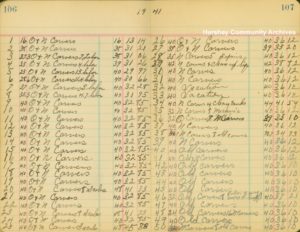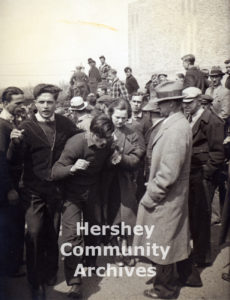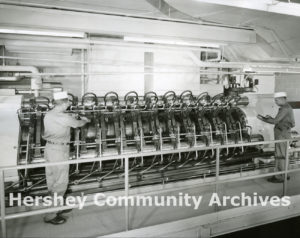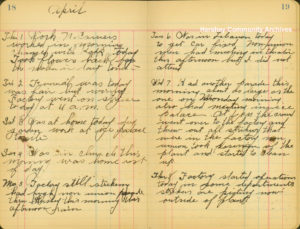HersheyArchives@30, Part 20: Eckenroth Journals – Working for Hershey Chocolate During the 1930s and 1940s

Daily journals are kept as a personal record of the activities in an individual’s life. Although never intended for a public audience, many journals provide us with a better understanding of what effect world-wide and local events had on an individual.
Raphael Eckenroth’s journals detail his work experience in the Hershey Chocolate Factory during the Great Depression and World War II. Born in 1908, Eckenroth began working for the Hershey Chocolate Corporation in 1928. Perhaps to accurately record his income during a period of financial uncertainty, or possibly due to a meticulous personality, Eckenroth recorded his daily wages and work assignments in the factory over a period of ten years.
The first column records the week of the year. The second column is the number of hours worked in the Carver room or other factory departments. The third column is total hours worked for the week. And the final two columns record his weekly income.
In the chocolate factory, Eckenroth worked primarily in the “Carver room” where “Carver” brand cocoa butter presses extracted cocoa butter from roasted cocoa beans. On occasion, he recorded how many hours each shift worked and the hours of operation for the “old” and “new” Carvers. These entries offer insight into the factory’s production schedule and the increase in hours and output during the war.
“All old carver presses started again to press and are operating three 8 hour shifts. The [new] carvers are operating two 7 hour shifts today.” -February 24, 1942
There is little information about the personal lives of the Eckenroth family in the journals. Deaths, major illnesses, and social activities are recorded, but Eckenroth rarely comments on the events he chronicles. He does however record personal reflections on the 1937 labor strike. The journals offer a timeline of events and Eckenroth’s feelings regarding unionization are evident.
In February 1937, the CIO began holding labor organizational meetings in Palmyra and negotiating an agreement with Hershey Chocolate Corporation. In March, an agreement between the company and the United Chocolate Workers of America (CIO) recognizing the union was reached, however not all areas of concern were addressed.
On April 2, at 11:00 AM, a “sit-down” strike was called and approximately 500 employees began occupying the factory. The strike impacted not only the non-striking employees but also the local dairy farmers who supplied the factory with milk each day. On April 7, after the strikers refused to vacate the building, non-striking workers and farmers forcibly removed the strikers from the factory. Strikers were forced to run a gauntlet and emerged beaten and bloody. A few weeks later the National Labor Relations Board conducted an election and polled employees as to whether they wished to be represented by the United Chocolate Workers of America. The employees overwhelmingly rejected the union.
“Had election today. C.I.O. had 786. Loyal 1542. Was happy day for Hershey. Spent the night drinking and being merry.” -April 23, 1937
Raphael Eckenroth worked for the Hershey Chocolate Corporation for 45 years until his retirement. His journals, although spanning a brief ten years, broaden our understanding of the Great Depression and World War II’s impact on the Hershey community and businesses. They also provide one man’s perspective on his relationship with Hershey Chocolate during one of the most violent periods in the community’s history.
#HersheyArchives@30


